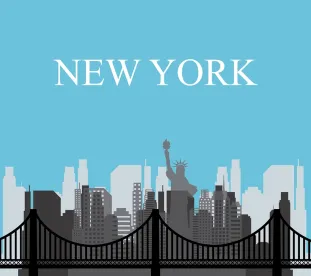In this episode of The Proskauer Brief, partner Harris Mufson and associate Arielle Kobetz discuss the New York City Commission on Human Rights (NYCCHR) enforcement guidance on appearance and grooming policies that ban or restrict naturally curly hair, dreadlocks, braids, cornrows and other hairstyles. While the guidance, which was issued on February 19, 2019, specifically details protections for Black people – who, according to the NYCCHR, are frequent targets of race discrimination based on hair – it also cites as unlawful “any grooming or appearance policies that generally target communities of color, religious minorities, or other communities,” which are protected under applicable law. So be sure to tune in as employers in New York City should review their current grooming and/or appearance policies to ensure compliance with these new guidelines.
TRANSCRIPT
Harris Mufson: Hello. Welcome to Proskauer Brief: Hot Topics on Labor and Employment Law. I’m Harris Mufson, and I’m here today with Arielle Kobetz. On today’s episode, we’re going to discuss recent enforcement guidance by the New York City Commission on Human Rights regarding Employer’s Policies on Grooming and Appearance. Arielle, on February 19, 2019, the New York City Commission on Human Rights issued new enforcement guidance on appearance and grooming policies that employers may adopt. Can you tell us a bit more about this guidance?
Arielle Kobetz: Absolutely, Harris. The City’s new enforcements guidance strictly prohibits appearance or grooming policies that restrict natural hair or hairstyles closely associated with Black people, because, according to the City Commission, such prohibitions are often rooted in white standards of appearance and perpetuate racist stereotypes that Black hairstyles are unprofessional. And in what may have been a direct response to some federal court’s reluctance to recognize hairstyle discrimination, New York City has become the first in the country to formalize this interpretation in official guidance. So, based on the guidance, employers may not enact policies that force Black employees to straighten, relax or otherwise manipulate their hair to confirm to employer expectations. This would constitute direct evidence of disparate treatment based on race or of some other relevant protected class under the New York City Human Rights law. Examples of violations may include policies that a ban or restrict naturally curly hair, dread locks, braids, corn rows and other hairstyles. The guidance provides some other helpful examples with policies or practices that would constitute discrimination, including telling a Black employee with locks that they cannot be in a customer-facing role unless they change their hairstyle; refusing to hire a Black applicant with corn rows because her hairstyle does not fit the “image” that the employer is trying to project for its sales representatives; or mandating that black employees hide their hair or hairstyle with a hat or visor.
Harris Mufson: So, does the guidance only address protection for Black employees, or is it broader than that?
Arielle Kobetz: It’s actually more broad than that. The Commission makes clear in its guidance that the New York City Human Rights Law protects the rights of all New Yorkers to maintain natural hair or hairstyles that are closely associated with their racial, ethnic or cultural identities. So while the Guidance does specifically detail protection for Black employees, it also cites as unlawful any grooming or appearance policies that generally target communities of color, religious minorities or other communities that are protected under applicable law. Examples of such policies could include a Sikh job applicant who’s turned down for religiously maintaining uncut hair kept underneath his turban, an Orthodox Jewish employee who is ordered to shave his beard and cut his payot or side-locks in order to keep his job. Another example would be a 60-year-old employee with gray hair who’s told to color their hair or lose their job; or, similarly, a male server who is ordered to cut his ponytail while similar grooming policies are not imposed on female servers.
Harris Mufson: Let’s just use that male server example for a moment. So, let’s say that a company or restaurant owner adopts certain grooming policies because they would comply, or are required to comply with certain health ordinances. How is that impacted here?
Arielle Kobetz: Well, so the guidance emphasis that employers may not ban, limit or otherwise restrict natural hair or hairstyles under the guise of speculative health or safety concerns. Generally speaking, the Commission’s viewpoint is that an employee’s hair texture or hairstyle has no bearing on their ability to perform the essential functions of a job. So, practically, when an employer has a legitimate health or safety concern, it should consider whether there are alternative ways to address the concern without imposing a ban on employees’ hairstyles. This could include, for example, requiring the use of hair ties, hairnets or head coverings. And the guidance also makes clear that employers cannot ban or limit such hairstyles in order to promote a certain corporate image or because of customer preference. So, employers who have these concerns should also consider other alternative ways to address those concerns.
Harris Mufson: So, what should employers be doing now to insure that they are complying with these new guidelines that were issued by the City Commission?
Arielle Kobetz: Employers in New York City should review their current grooming and/or appearance policies to ensure compliance with these guidelines. Employers should also make sure that managers or supervisors who are implementing these policies are aware of and are trained on this guidance — particularly those who interview job applicants. The trouble is often not with the policy itself, but with how it’s implemented by supervisors and managers on a regular basis.
Harris Mufson: So, Arielle, thank you for briefing us on those recent developments and thank you for all of our listeners for joining us on the Proskauer Brief today. Stay tuned for more insights on the latest hot topics in Labor & Employment law, and be sure to follow us on iTunes, Spotify and Google Play.




 />i
/>i

